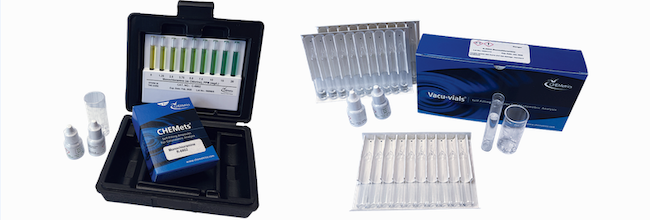Monochloramine Test Kits

Visual Kit
| Range | MDL | Method | Type | Test Kit | Refill |
|---|---|---|---|---|---|
| 0 - 20 ppm | 0.625 ppm | Hydroxybenzyl Alcohol (HBA) | CHEMets | K-6802 | R-1402 |
Photometric Kit
| Range | Method | Type | Test Kit |
|---|---|---|---|
| 0 - 15.0 / 0 - 8.00 ppm | Hydroxybenzyl Alcohol (HBA) | Vacu-vials | K-6803 |
CHEMetrics test kits for the determination of Monochloramine in aqueous solutions employ the well-known Hydroxybenzyl Alcohol (HBA) method to deliver sensitivity and accuracy within minutes. Based on CHEMetrics patented Self-Filling Reagent Ampoule technology. Premixed. Premeasured. Precise. Visual and instrumental monochloramine testing kit formats. CHEMets® visual test kits use colour comparators for analysis while Vacu-vials® instrumental kits rely on CHEMetrics direct-readout photometers or spectrophotometers capable of accepting a 13-mm diameter round cell. Each kit contains 30 tests. Suitable for potable water and municipal wastewater testing.
Hydroxybenzyl Alcohol (HBA) Method
Monochloramine reacts with hydroxybenzyl alcohol (HBA), in the presence of sodium nitroferricyanide, to form a green coloured complex. This test method measures monochloramine only. Results are expressed in ppm (mg/l) monochloramine as chlorine, NH2Cl-Cl2.
CHEMetrics offers ammonia test kits employing the HBA chemistry that can be used in conjunction with the monochloramine kits to determine free ammonia concentration.
References:
Krom, Michael D., Spectrophotometric Determination of Ammonia: A study of a Modified Berthelot Reduction Using Salicylate and Dichloroisocyanurate, The Analyst, V105 pp. 305-316, 1980.
Applications
Free chlorine is the primary disinfectant employed in drinking water as it is a strong oxidising agent and disinfectant and is effective at killing or inactivating pathogens such as bacteria, viruses and parasites. Chloramines in comparison are less efficient as disinfectants but are more stable and persist longer in solution, providing greater disinfection contact time. Chloramines also produce fewer disinfection by-products (DBP), namely trihalomethanes (THMs) and haloacetic acids (HAAs).
Monochloramine has been used for approximately a century as a disinfectant to treat drinking water in municipal water facilities. It is commonly added to drinking water to function as a secondary disinfectant in a process called chloramination. The secondary disinfectant supports the primary disinfectant, chlorine, and maintains a disinfection residual as it passes through the drinking water distribution system.
Water age is the length of time water spends in the distribution system. The higher the water age, the longer the reaction time for the disinfectant residual and correspondingly the lower the disinfectant residual concentration, which increases the potential for pathogen growth and lowering of water quality. High water age can result from oversized tanks and pipes, long pipe networks, decreased water demand, dead-end mains, or inadvertently closed valves.
Where mono-chloramination of drinking water is carried out, it is generally employed on water supplies with either long pipe networks, with raw water sources that are discoloured or high in organic matter, or where there are elevated levels of Trihalomethanes (THMs) present.
Testing monochloramine levels is critical to ensure that the correct dosing of drinking water supplies is being carried out, to avoid insufficient dosing and disinfection capability as well as the converse.
Please see our monochloramine article for more information.
What is Monochloramine?
Chloramines are a group of chemical compounds that contain ammonia (NH3) where one or more N-H bonds has been replaced by an N-Cl bond. It includes both organic and inorganic cmopounds. More complex chloramines contain carbon chains or aromatic rings, and sometimes other atoms such as sulphur. The simplest chloramine is monochloramine (NH2Cl) is often referred to as ‘chloramine’. Monochloramine is a colourless liquid that is soluble in water.
Monochloramine is formed by the reaction of free ammonia (NH3 and NH4+) with free chlorine. Dichloramine (NHCl2) and trichloramine (NCl3) will also form if free chlorine remains in solution after all free ammonia has been converted to monochloramine. Dichloramine and trichloramine are less effective at disinfection and impart an unpleasant odour to the water and are generally therefore not the preferred secondary disinfectants in chloramination processes.